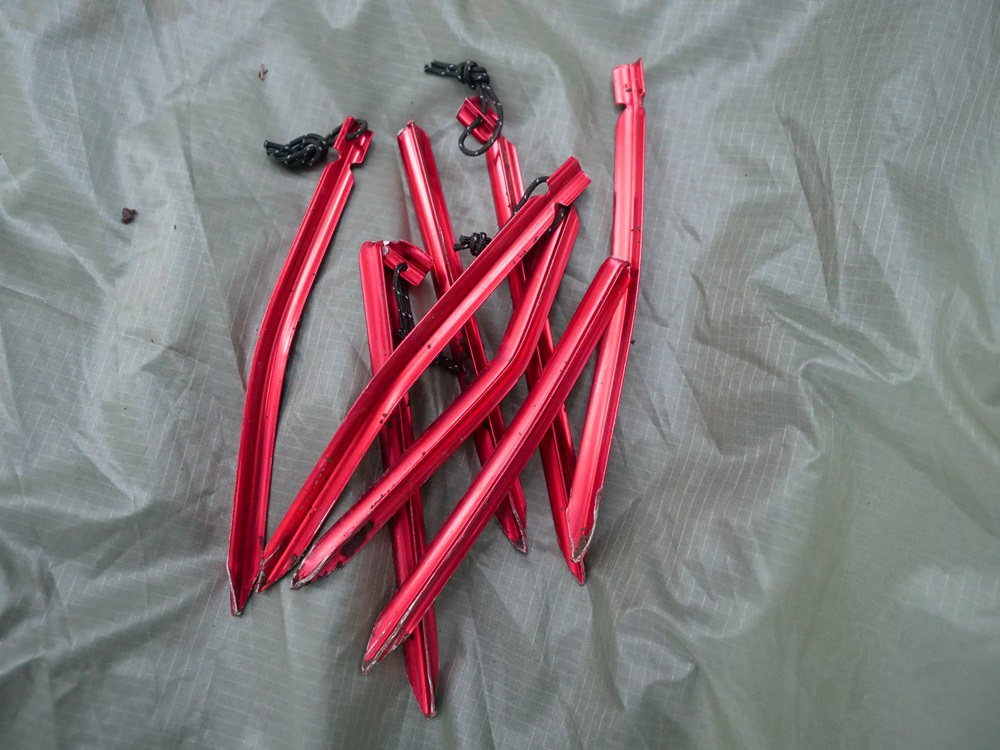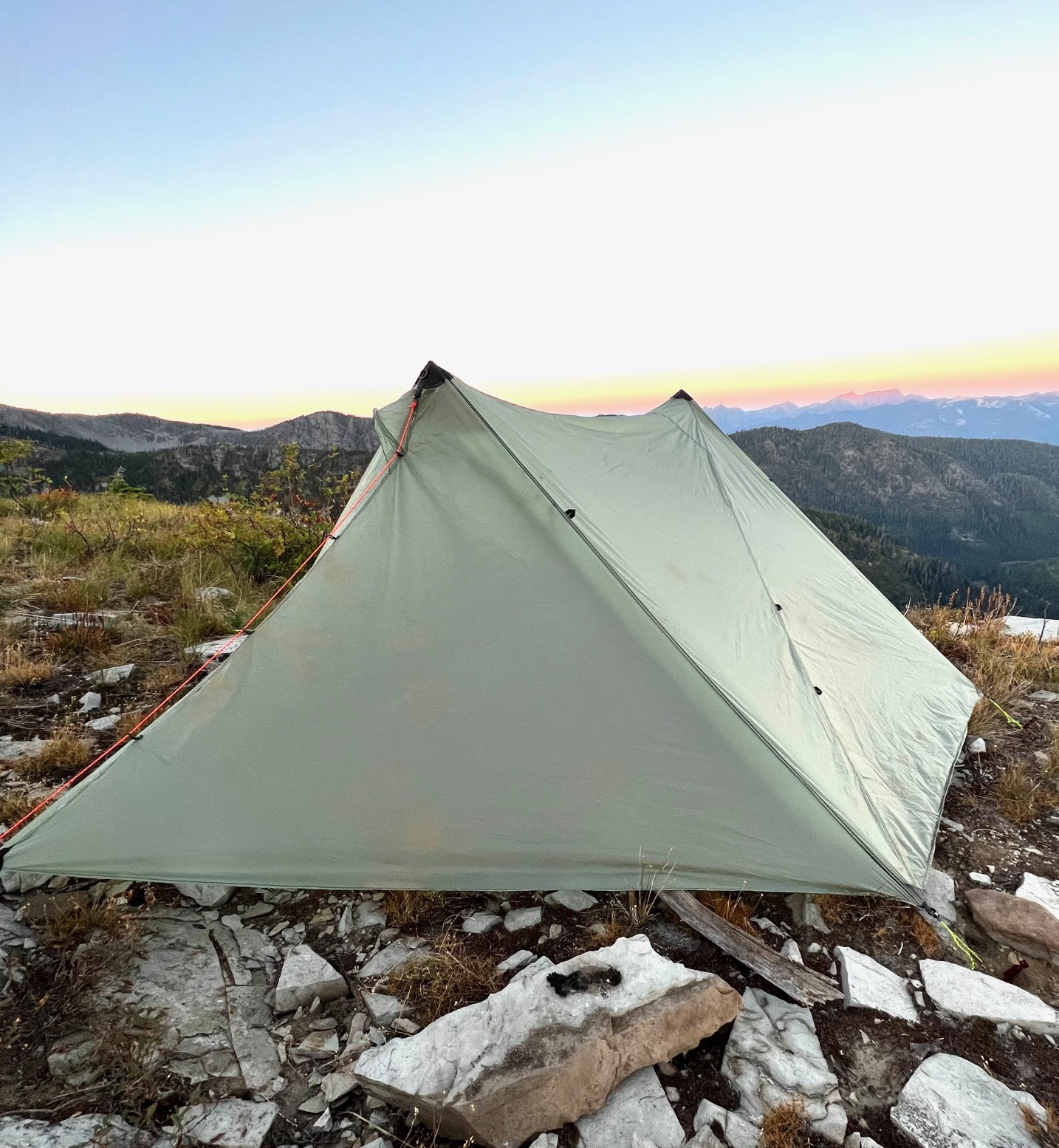
Floorless shelter discussions are always a dominant topic in the Rokslide forums. A diverse range of makes and models are critiqued, analyzed, and questioned for every imaginable scenario. Inevitably, the discussion turns to the use in insect and snake country, where most would prefer something with a floor. Small-footprint double-walled tents abound in the backpacking market and work well in these scenarios. Yet there is a lack of single-wall shelters that are not only lightweight but also have a well-dimensioned interior. The Seek Outside Sunlight is simple to pitch like a floorless shelter, spacious, and has a built-in bug net and floor.
It’s been four seasons since reviewing Seek Outside’s single-person Silex and one season since reviewing the two-person Guardian. Like the Sunlight, both are pitched with trekking poles or small carbon poles and have a spacious footprint. This allows a context to compare the Sunlight to these trekking pole style tents in the Seek Outside line.

Seek Outside Sunlight Features
Seek Outside released the Sunlight two-person shelter in 2023 as a floored and screened option to their other trekking pole shelters. It is similar in size to the Eolus and pitches with two trekking poles and six stakes (minimum) in a hexagon shape. The pitched dimensions are 12’ by 8.25’, equating to a 70-square-foot outline. The floored sleeping area between the poles is 5’ by 8.25’ and is 38 square feet in area. The height of the peaked ridgeline is 50”. The canopy and bathtub-style floor are made of 30D Cordura silnylon fabric coated in a blend of silicon and polyurethane which makes the coating less tacky, minimizing the sticking of grit and sand. The interior mesh panels have full-length, two-way zippers on both sides of the shelter and two vestibules under the main canopy. More specifics can be found here.
Like the other trekking pole style tents in the Seek Outside lineup, the Sunlight uses a zipper-less door opening. In place of a zipper, a pair of line locks slide up and down a tight guy-out line, which raises and lowers the fabric of the door. This configuration saves weight and eliminates the potential of a failed zipper in the field. The total weight of the seam-sealed shelter, including eight stakes, stake loop cordage, and stuff sack, comes in at exactly 2.4 pounds. This total does not include the weight of the required trekking poles or the optional carbon poles which can be purchased from Seek Outside.
The provided stakes (an MSR lookalike) were an issue throughout the season as they are soft and easily bent when placing in harder ground, with most of the heads breaking with moderate force applied. Users will want to replace these from the start. Also, note this shelter does not offer the ability to use a stove as the floor is not removable.

Field Use
I started using the Sunlight shelter at the start of summer when insect populations are multiplying and is the tail end of our wet season. Throughout the summer, backpacking trips were used to understand how the floor and mesh interior perform during peak of mosquito levels and continued its use into the fall archery and rifle seasons giving the shelter a workout in severe weather.

The Sunlight shelter is the easiest to pitch of the trekking pole shelter lineup as the floor is sewn in and the first four stakes tension the floor. Once the poles are inserted and vestibules staked out the shelter will have a tight ridgeline and taught sidewalls. Seek Outside produced a video on pitching the Sunlight, which explains this technique in detail and can be found here. https://youtu.be/23eeX4_jv_4
Staking out the four corners and two doors is the bare minimum needed for shelter setup. There are two additional guy-outs on the canopy’s head and foot which can be utilized for extra interior room and when maximum wind resistance is needed.

Livability and Space
The interior of the Sunlight is sprawling for a single user and comfortably fits two with plenty of room to sit upright. The 8.25’ length will be plenty for a tall user with use of the guy-outs at the head and foot of the shelter. Tensioning these walls adds extra room and keeps sleeping gear from touching any condensation. The double vestibules are spacious and easily fit backpacks, cook systems and weapons. With two people, the two doors make entry and gear organization simple. The zipper-less closure systems on the vestibules are easy to operate and secure in high winds and wet weather.

The sewn-in bathtub floor is incredibly durable and waterproof, offering more weather protection during wet conditions where wind could blow moisture under the canopy. The floor minimized interior overnight condensation when pitched on wet ground as it acts like a vapor barrier, keeping a lot of ground-sourced water vapor outside of the shelter. The one issue encountered with the floor was the slippery nature of the material. If there is any slope on the sleeping area, gravity will eventually pull you in that direction. The mesh panels sewn into the floor worked well and eliminated any insect or rodent ingress. The zippers on the mesh doors are four-way, durable, and easy to operate. Overall it is a spacious and comfortable shelter.

Finding an ideal pitching space on tight mountain ridgelines or sustained steep ground can be a problem for any tent design, more so with big footprinted shelters. The Sunlight is a great balance of livable space and a small footprint where finding a site that is brush-free, flat, and large enough isn’t usually an issue. The six-sided, 70-square-foot outline of the shelter is small enough to fit in almost any type of terrain. Using the Sunlight this past summer and fall, I could always find an ideal spot to pitch it.

Weather Protection and Stability
The Sunlight performed favorably in the insect-rich areas of the Northern Rockies and held up to its fickle weather as well. The shelter had the seams sealed at the factory (a $55 add-on) and did not leak from heavy downpours, wind-driven rain, days of constant drizzle, or wet snowfall. The silnylon of the tent canopy absorbs water slightly, causing the shelter to stretch and subsequently sag when wet. The catenary cut of the Sunlight’s panels creates a center ridge where the pole tips in the vestibules are slightly higher than the middle. This design makes it easy to tension the shelter as the fabric stretches as does the tensioning stake loops and guy outs. The tight pitch keeps the shelter from flapping in the wind.

Snow loads slough easily from the canopy panels although it will build up along the lower edge of the shelter. Tensioning the guy outs at the head and foot of the shelter will help with snow build up as it will steepen the wall. If they are not used the lower angle head/foot walls will accumulate more snow than the steeper angled vestibule doors. Depending on the storm, clearing of snow may be needed every few hours to maintain maximum interior space. This shelter is not designed to be handle four-season use but will get most hunters into the early portions of late season if used with caution.
Single wall shelters can have issues of condensation in more humid conditions and the Sunlight generated moderate amounts of condensation in the wettest conditions. As stated earlier, the sewn in floor helps limit saturated ground water vapor from getting into the living space, but the vestibules still contribute as there are floorless. Any wet weather event will increase condensation inside the shelter, but heavy snowstorms maximize it. Snow pileup along the bottom edge of the vestibule creates a tight air seal, limiting ventilation and trapping users warm wet exhaled breath. When weather is more mellow, pitching the Sunlight with a gap along the bottom edge of the vestibules maximizes air flow and pushes moist air out.

Overall Thoughts
The Sunlight is a great shelter for hunters looking for a lightweight shelter that will cross over for summer use in insect season. It would be a great option for people camping in country with abundant snakes and/or rodents. The sewn in bathtub floor and mesh netting provide great protection from all the creepy-crawlies out there. The shelters canopy offers great weather protection, a comfortable living space for two, and pitches in fairly tight spaces. It packs small and pitches incredibly easy. The catenary cut of the ridgeline makes for a tight pitch and a quiet shelter in the wind. This tent is a fantastic option for summer backpacking trips, early fall hunts into the mid-season. It is a very versatile backpacking and hunting shelter.

Price Breakdown
- Sunlight 2p shelter: $449
- Optional carbon poles (2): $98
- Factory seam sealing: $55
You can order yours here.

Comment or ask Josh questions here.




















